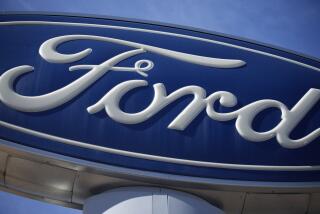A 64-mpg Ford? Only in Europe
- Share via
WAYNE, MICH. — Next month in Britain, Ford Motor Co. will begin selling a diesel hatchback that gets 64 miles per gallon. Across the channel, Parisians can buy a new gas-powered compact made by General Motors Corp. that gets a nifty 47 mpg.
On these shores, neither carmaker sells anything that thrifty. Yet with Americans clamoring for fuel-efficient cars and Detroit automakers on the ropes thanks to crashing sales of gas-guzzling trucks, the question is, why aren’t these vehicles here now?
Ford and GM say that importing them from Europe isn’t an option because of unfavorable currency exchange rates. Instead, they’re racing to convert U.S. plants to produce them here. One of the first is the Michigan Truck Factory, home to the Lincoln Navigator and Ford Expedition, which both get about 14 mpg.
Ford will shut down this half-century-old plant next month and begin the arduous process of converting it to a factory in which the current European version of the Focus will be built in 2010. Ford is also preparing to retool truck factories in Louisville, Ky., and Cuautitlan, Mexico, to make five more European-style compact cars for the U.S. market.
“This is critical for us,” said Bill Russo, Ford’s head of manufacturing, walking past rows of roof assemblies in the Michigan Truck Plant’s body shop. “We absolutely need to make more smaller vehicles as soon as possible.”
It’s a hugely ambitious logistical and engineering challenge. To switch from trucks to cars, Ford will have to replace thousands of tools on the line, recalibrate a massive production process, establish new supply chains with hundreds of part makers and negotiate with the United Auto Workers union. Even with help coming in the form of federally backed loans, the financial burden will be tremendous.
The payoff is a chance to regain the market share lost to imports like Toyota and Honda -- this year, for the first time, fewer than half of the cars sold in the U.S. have been American brands. But if the Big Three are unable to deliver, experts say, the consequences could be disastrous.
“There is no going back to 2004,” said David Healey, auto industry analyst at Burnham Securities. “The American automakers need to make small cars and they need to make profits on small cars or they simply can’t continue.”
For Ford, that starts in Wayne, half an hour’s drive west of Detroit. The Michigan Truck Plant once ran three full shifts, 24 hours a day, 3,000 union men building trucks. Today, only one shift toils.
In a few weeks, that shift will hear its last whistle. The 1,000 remaining workers will join Ford’s U.S. Focus plant across the street. Then the company will begin dismantling much of the assembly line and send the tooling to its truck plant in Kentucky. In Wayne, Ford will recalibrate the machinery, build new tooling, reprogram the paint shop and reformat the assembly line.
A complete makeover can cost up to $250 million per plant -- and this is one of Ford’s most agile factories, meaning that the changes required to switch it over to producing a new vehicle are relatively minor. According to Ron Harbour, an industry consultant at the Oliver Wyman Group, retooling older, non-flexible plants involves “driving a bulldozer from one side of the factory to the other, clearing everything out” at much greater expense.
But before the robots are powered down, Detroit execs have had to update their thinking about what Americans want to buy.
For years, Ford and GM have been building high-end compact cars for Europe, routinely winning awards for such models as Ford’s Mondeo and GM’s Vauxhall Corsa. The cars emphasized high-end detailing and offered options reserved on these shores for premium brands. They cost more, but consumers happily paid because in Europe, Ford and GM are premium brands.
At home, meanwhile, Detroit kept outfitting fuel-efficient cars with crank windows and cheap upholstery. In Germany, a Focus starts at 15,250 euros, or about $20,500. In Germantown, Pa., the less-refined U.S. Focus starts at $14,995. That $5,000 gap, experts say, is the difference between profit and loss on a smaller car.
Until recently, the Big Three were willing to produce unprofitable small cars just to draw customers to dealerships, where they would often upgrade to larger sedans, or highly profitable trucks or sport utility vehicles. When truck sales slipped, Detroit still resisted bringing in European cars because they felt that the weak dollar and differing consumer expectations, not to mention the expense of altering them to comply with U.S. safety and emission standards, made them untenable here.
“I wish I could bring the European Focus to the U.S.,” Jim Farley, Ford’s head of sales and marketing, said in January. “But it’ll never work in this market.”
But $4-a-gallon gas, plummeting truck sales and billions in quarterly losses changed Farley’s tune. In July, Ford said it would bring six of its European cars across the pond.
In August, GM said it would spend $500 million to bring the Cruze, a four-cylinder, 40-mpg compact originally targeted for Europe, to the U.S. About $350 million of that will go to retooling the Chevrolet Cobalt plant in Lordstown, Ohio, to make the Cruze, which should cost significantly more than the $15,850 Cobalt.
Like the U.S. Focus, the Cobalt has razor-thin profit margins, and because the 5-year-old design was due for an update, GM said it made more sense to replace it with the Cruze.
Meanwhile, GM is spending $500 million more on the Chevy Volt, a new kind of hybrid that will go 40 miles on battery power alone and is stuffed with fancy digital touch screens. It will be built at the plant in Hamtramck, Mich., currently home to the boat-like Cadillac DTS and Buick Lucerne, neither of which top 21 mpg. Pricing on the Volt hasn’t been finalized, but it could run as much as $40,000.
“The idea is to get American luxury car buyers to buy luxury small cars,” said Mark Warnsman, auto analyst at Calyon Securities.
Chrysler, the smallest of the Big Three, is in a different boat. With virtually no international presence and a lineup that’s three-quarters trucks and SUVs, Chrysler doesn’t have many small cars to lose money on. But with its U.S. sales down 25% through September compared with last year, the company is trying to boost fuel efficiency in myriad ways.
In one deal forged this year, Chrysler will use its factories to build trucks for Nissan Motor Co., which in turn will build small cars under the Chrysler, Dodge or Jeep names. Another has Chinese automaker Chery producing small cars under a Chrysler badge. Last month, Chrysler debuted plug-in hybrid versions of its Jeep Wrangler and Town & Country minivan, plus a battery-powered speedster.
“The market has its foot on our neck right now,” said Jim Press, a vice chairman at Chrysler who came to the company from Toyota last year. “This is a new paradigm.”
All three companies hope more efficient cars will appeal to buyers. But they also need to make them compliant with fuel-efficiency regulations. Estimates of the industry tab to reach the new 35-mpg standard by 2020 range from $80 billion to $100 billion.
To defray some costs, President Bush this month approved government guarantees for $25 billion in loans to carmakers and suppliers. They offer rates at less than a third of what the industry currently pays to borrow in the open market, prompting some to call them a bailout. But insiders say they’re necessary.
“The new standards are a huge burden, so this is an essential source of capital,” said David Cole, chairman of the Center for Automotive Research.
Although the rules for the loans are still being drafted, they probably will be applied to projects in old plants that yield at least a 25% increase in fuel efficiency. Ford’s Russo, for one, believes the Michigan Truck Plant will qualify.
Above his head, robot arms trundle door assemblies toward truck bodies. Amid sparks from robot welders, he points out the countless parts that will be replaced to prepare the factory for the Focus.
“This is exactly the kind of project the government should help fund,” he said. “It’s going to change the kind of vehicle America drives.”
--






